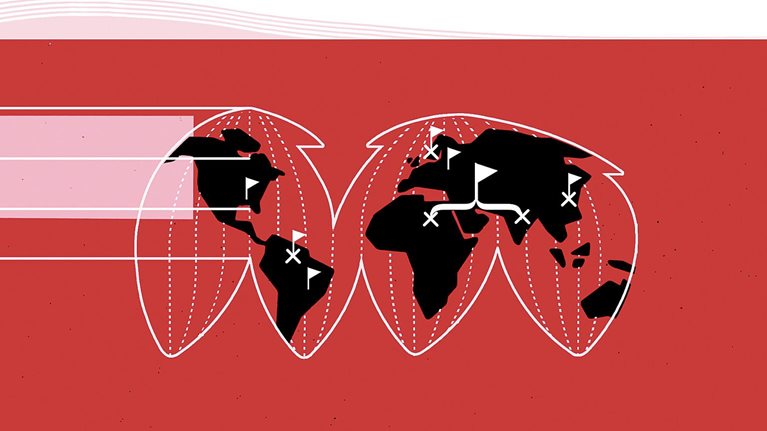Recent swings in global currencies have brought exchange-rate risk back to the forefront for companies working with suppliers, production, or customers in different currencies. Although official, or “nominal,” exchange rates tend to draw the most attention, what really matters to companies are changes in real terms—that is, when currency changes are adjusted for differences in inflation. In an ideal world, if prices were to fall as currency values rose, or vice versa, then the purchasing power of companies’ cash flows would be stable, and there would be no real currency risk. That often works itself out over the long term, but not for all currencies and not necessarily in the short term.
Many companies seem to manage only the most visible risks, such as exposure from a large transaction in a developing nation, which can be hedged with financial instruments, including currency futures, swaps, or options. But these tactics don’t work for every currency risk—and companies often face far greater exposure from less obvious risks that are much more difficult to manage, including risk that stems from mismatches between costs and investments in one currency and revenues in another.
What follows is a refresher course of sorts on currency-risk management for companies seeking to get a better handle on the potential impact of currency-rate changes. The most important lesson is that managers can’t always hedge against every currency risk—and often shouldn’t try. But once managers understand how different risks work and interact, they can better measure and manage them with the help of a few general tips we’ve collected from experience.
Decide which currency risks to manage
Understanding where and how currency fluctuations affect a company’s cash flows is not straightforward. Many different factors—from macroeconomic trends across countries to competitive behavior within market segments—determine how currency rates affect a business’s cash flows. Mathematical risk-management tools1 can help managers analyze their risk, but it is even more important to understand where and how exchange rates can distort the value of a company through portfolio risks, structural risks, and transaction risks. Each influences value and cash flows in different ways and requires a different approach for risk management.
Portfolio risks. Any company with business operations in foreign currencies will be exposed to so-called currency portfolio risks. Take, for instance, a Dutch food retailer operating stores in the Netherlands and the United States. Due to the nature of the supply chain, costs and revenues for its retail stores are mostly set in local currency—unexposed to exchange rates. But the company is inevitably exposed to portfolio risk because cash flows from its US operations will fluctuate with the exchange rate when translated into euros for financial statements, performance management, or investor communications.2 Portfolio risk by itself is rarely large enough to cause financial distress for a company. In this case, a 5 percent change in the exchange rate, up or down, would lead to the same 5 percent change in the company’s cash flows from its foreign operations. It could not annihilate the cash flow or turn a positive cash flow into a negative one.3
Because portfolio risk is unlikely to cause financial distress, this is in general not a risk that companies need to actively manage.4 In addition, the exposure is different for different shareholders, depending on their home currency. For example, it would be hard to decide whether a global company with global shareholders, such as consumer-goods company Unilever, should hedge its exposure measured in British pounds, euros, or dollars. Fortunately, shareholders can easily hedge Unilever’s portfolio currency exposure by themselves via futures positions, if they desire to do so.
Structural risks. These risks occur when a company’s cash inflows and outflows react differently to currency changes. Take, for example, a German brewing company’s beer exports to the United States. Because it generates sales in US dollars but incurs costs for these sales in euros, the company is exposed to both portfolio risk and to structural risk—which has a much bigger impact on its net cash flow from US operations (Exhibit 1). Let’s assume that the company’s US operations generate a cash margin of 15 percent of sales in dollars, with all costs in euros. In this hypothetical case, a mere 5 percent drop in the dollar would deflate the cash margin to 11 percent. In dollars, that would be a 28 percent decline in cash flow; in euros, it’s nearly 32 percent.5

Structural risk can significantly affect a company’s cash flows and even trigger financial distress, especially when cash-earnings margins are thin. For our German brewer, for example, a 17 percent drop in the dollar would turn cash flows from US operations negative. Of course, inflation could bring prices in the United States and Germany back in line with the exchange rates between the dollar and the euro, but this could take several years.6
Because they are rooted in a fundamental mismatch in cash flows, structural risks are also the most difficult to manage.7 The German brewing company exporting to the United States cannot use financial instruments to hedge the structural risk because of the size and duration of the exposure (it would require hedging the full amount of dollar-denominated revenues for all future years in business). The only effective way to reduce structural exposure is to reduce the underlying mismatch of cash flows. For example, automobile manufacturers from Germany and Japan having shifted production to the United States, thereby lowering their structural exposure to the dollar.8 Such “natural hedges” only work if the associated costs aren’t too high and if they don’t put competitive advantages at risk. The German brewer can only sell its beer as a premium import in the US market if it is brewed in Germany.
Transaction risks. As the most visible currency risks a company faces, transaction risks are also the simplest to measure and manage. These occur as a result of timing differences between a contractual commitment and actual cash flows. Suppose a company manufactures a product in China and sells it in the United States for a price set in dollars. If the payment terms allow the buyer to pay days or weeks later, the company’s cash flow will be exposed by currency movements while it waits for settlement.9 Transaction risks typically affect short-term cash flows and are unlikely to put a company into financial difficulties except for extreme cases—for example, when it commits to very large purchases or sales that are fixed in a foreign currency.
Managing transaction risk is relatively straight-forward with financial instruments because each transaction is clearly definable and mostly short term. Many companies have hedging programs for their operating cash flows from foreign operations.
Which currency risks can be managed?
Companies may have good reasons for managing currency risk—for example, to facilitate planning and performance management or for tax purposes.10 In general, they should not manage currency risk just for the sake of lowering cash-flow volatility or boosting share price. Shareholders are well aware of the currency risks faced by the companies they invest in and can manage any associated volatility themselves by appropriately diversifying their investment portfolio. Furthermore, in the long term, currency fluctuations tend to be offset by price changes, thereby reducing currency risk in real terms. As academic research shows, investors therefore do not require a risk premium for bearing currency risk, and companies with lower currency risk will not experience a lower cost of capital.11
Instead, managers should focus on those currency risks that could lead to financial disruption or distress. Deciding how much currency risk is acceptable should be similar to deciding how much debt is acceptable: it depends on a company’s risk appetite. That risk appetite could be expressed as a target default probability, cash flow at risk, or simply a target coverage ratio or credit rating. Given the target, managers should identify which currency risks are acceptable and which are not. When natural hedges are not an option, companies need to be prepared to reduce their chances of distress in other ways, for example, by adopting a capital structure with less debt relative to peers that don’t have currency risk.
There are many frameworks and step-by-step guides for measuring and managing a company’s currency risk.12 Rather than enumerating yet another set of steps, we offer instead several higher-level recommendations for managers.

Would you like to learn more about our Strategy & Corporate Finance Practice?
Take a holistic perspective
Currency risks should not be managed in isolation, as they may well offset one another. For example, if a European airline were to order a Boeing aircraft, priced in dollars, for delivery a year from now, it might buy the dollars it will need today or enter into a forward contract to buy them in a year. That allows it to hedge against a drop in the euro so that the cost of the aircraft is fixed in dollars at today’s exchange rate. But if the airline also has long-term net cash inflows from passenger tariffs set in dollars, then that transaction hedge effectively increases, rather than decreases, its exposure to changes in the dollar. Understanding where and how currency risks offset one another in a company’s portfolio across businesses and time is critical for effective management of these risks.
Focus on cash flow, not earnings
Unfortunately, current accounting practices do not draw the attention of managers and investors to the most important types of currency risk. For example, a company’s income statement contains information about “foreign-exchange income or gains,” and its equity account shows the cumulative adjustments from translating foreign currency–denominated assets and liabilities to the home country’s balance sheet. But the amounts reported show only parts of a company’s transaction and portfolio risk.
The most important impact of currency changes, which comes from structural risk, finds its way into the income statement through movements in revenues and costs but not as an explicit line item. In fact, standard financial reports can even lead to the wrong conclusions about a company’s exposure to movements in currency rates or commodity prices by overemphasizing the accounting effect on earnings rather than the real effect on cash flows.13 Managers should focus on the potential risk to cash flows rather than on accounting risks such as fluctuations in reported operating profit, foreign-exchange income/gains, or translation results in equity.
Understand limitations of financial instruments
Financial instruments such as futures, swaps, and options can effectively hedge well-specified, short-term currency risks such as transaction risks. But the most important risks are often not as well specified or long term. Take the example of a US consumer-goods company exporting to China. Its cash-flow exposure to changes in the renminbi exchange rate depends on competitor actions and consumer preferences. Moreover, since the company has made long-term investments in consumer brands and distribution channels, its exposure is large and stretched out over many years. Indeed, the size and duration of such risks make it impossible to effectively hedge with financial instruments.
In some cases, hedging short-term structural risks can buy time for management to react with operational or strategic measures, such as renegotiating pricing contracts, finding opportunities for cost reductions, or relocating production. For example, airlines can hedge their fuel costs, but such a move is only effective for about 12 to 18 months. That reprieve can secure cash flows for fixed commitments, giving airlines time to cut costs or raise prices to respond to fuel-price changes.
Be more transparent with investors
Companies today often describe their currency-hedging strategy in detail in their financial reports. Unfortunately, these strategies mainly address transaction or short-term structural risks and fail to provide shareholders any real insights into the type and size of long-term structural risks a company faces—or which of them it actively manages and why. And they often focus on the accounting impact of currency risk and their efforts to mitigate it rather than the impact on cash flow.
Investors are better off when companies report the past impact of currency fluctuations on their operating earnings or, even better, on their operating cash flow. If relevant, this disclosure could be by business segment and by currency. Philips, for example, discloses key factors affecting its operating earnings, including currency changes. Ideally, this would be followed by an estimate of how the exchange rate would affect future revenues and operating profits. Alcoa includes estimates of the sensitivity of its net income to changes in five major exchange rates (Exhibit 2). This would also fit with best practice in forward revenue and earnings guidance: clarifying what managers can influence and what they cannot. It is surprising how few large international companies explain their key assumptions underlying forward guidance—an easy way to discuss risks and uncertainties with shareholders.

Companies are susceptible to a range of currency risks, but not all of them are risks they can or should try to manage. Managers would do well to take a holistic approach that focuses on the effect on cash flows rather than earnings and to be aware of the limitations of financial instruments. They should also be more transparent with investors about what risks they face and their efforts, if any, to hedge them.


